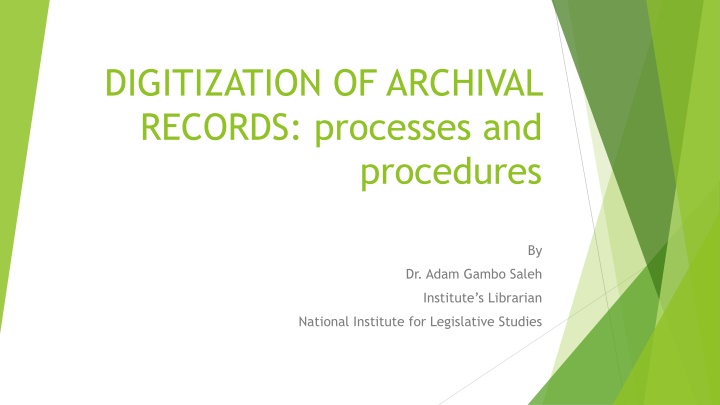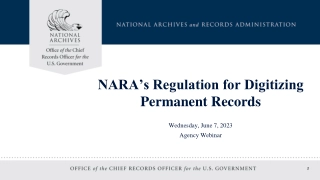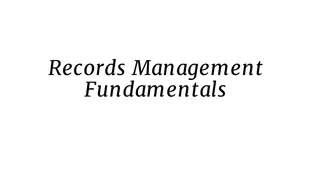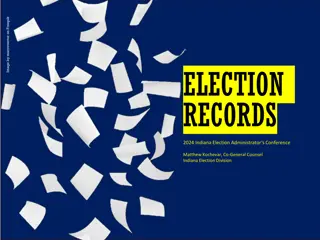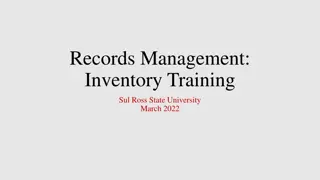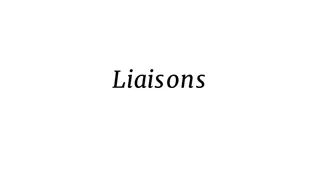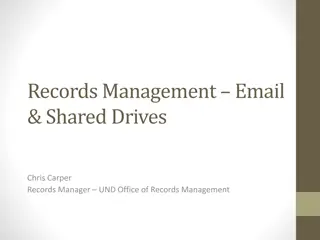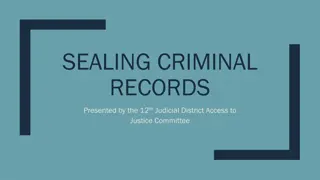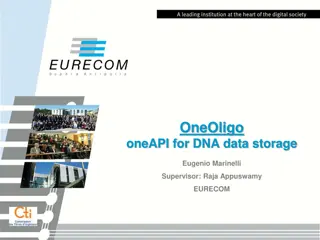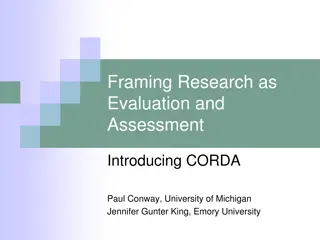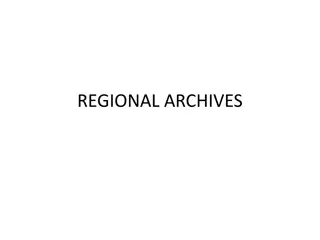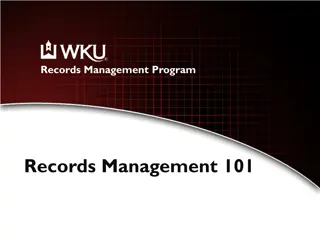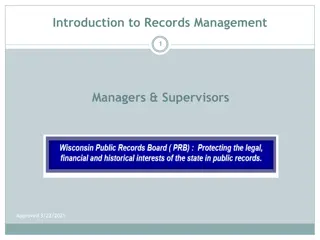DIGITIZATION OF ARCHIVAL RECORDS: PROCESSES AND PROCEDURES
Archival records hold primary sources accumulated over time, showcasing the function of individuals or organizations. Digitization is the conversion of analogue content into digital form for enhanced access, preservation, and reduced handling of fragile materials. This process involves converting materials like photographs, films, manuscripts, and printed texts into digital formats for easy machine readability and standardization. The purposes of digitization include improved access, preservation, and reduced physical handling of delicate materials. Considerations for digitization projects revolve around the project's purpose, intended users, and implementation strategies.
Download Presentation

Please find below an Image/Link to download the presentation.
The content on the website is provided AS IS for your information and personal use only. It may not be sold, licensed, or shared on other websites without obtaining consent from the author.If you encounter any issues during the download, it is possible that the publisher has removed the file from their server.
You are allowed to download the files provided on this website for personal or commercial use, subject to the condition that they are used lawfully. All files are the property of their respective owners.
The content on the website is provided AS IS for your information and personal use only. It may not be sold, licensed, or shared on other websites without obtaining consent from the author.
E N D
Presentation Transcript
DIGITIZATION OF ARCHIVAL RECORDS: processes and procedures By Dr. Adam Gambo Saleh Institute s Librarian National Institute for Legislative Studies
What is archive ? Can mean either:- Historical records Location Archives contain primary source documents that have accumulated over the course of an individual or organization's lifetime, and are kept to show the function of that person or organization. archives to be records that have been naturally and necessarily generated as a product of regular legal, commercial, administrative or social activities. They have been metaphorically defined as "the secretions of an organism and are distinguished from documents that have been consciously written or created to communicate a particular message to posterity.
What is Digitization ? the process by which analogue contents is converted into a sequence of 1s (ones) and 0s (zeros) and put into a binary code to be readable by computer (Hughes, 2004). Digitization is the transformation of analogue information from whatever form and from whatever support to digital code using computer technologies. This may include electronic snapshots taken of a scene or photographs, films, manuscripts, printed texts and artworks scanned from documents (Cornell University Library, 2001). Digitization process converts archival materials from formats that can be read by people (analogue) to a format that can be read only with the help of machines (digital). It is a process of taking a physical object (analogue contents), and taking photographs of or scanning the item and transferring the photographs into a digital medium. It is also a process of archiving born digitals into the institutions collections.
Digitization encompasses:- acquiring, converting, storing and providing information in digital format that is standardized, organized and available on demand.
PURPOSES OF DIGITIZATION Enhanced access. This is the most obvious and primary reason, mainly for research purposes. Where there is high demand from users and the library or source has the desire to improve access to a specific collection, digitization is the first choice. To facilitate new forms of access and use. The main purpose in this case is to enable the use of such originals that cannot be consulted without a visit to the specific repository, as also those originals that are fragile or damaged and where technology is needed to reveal the content and shape. For preservation. The purpose is, in the first place, to create accurate reproductions of the original documents on a long lasting medium. Reduction in handling. Reduce the handling and use of fragile or heavily used original material and create a back up copy for endangered material.
Considerations for digitization What is the purpose of the digitizing project? Who will be the users of the digital surrogates? How will the digital surrogates be presented? What will be the effect on the original collection item of making the digital surrogate? How will the digital files be accessed and stored ?
Guidelines for Digitization of Archival Material Selection of materials Treatment/Conservation/Handling of materials Equipment Selection Image capture Subject Metadata Image processing and cleaning Quality control as per Output Specifications Integration Short Term Storage Long Term Retrieval Migration Policy
Selection of Material It is important to see digitization as a series of choices where competing requirements and demands have to be balanced. When selecting source material for digitization it comes down to three basic questions whether the source material:- oNeeds to be converted? o Should be converted? o Can be converted?
Factors affecting selection Physical Condition readability :- Selection of material for digitization will be affected both by its physical condition and by readability. Material, which is fragile, damaged and in poor condition may present too many risks of further damage being caused by handling to allow it to be scanned without special care or without some basic conservation techniques. Demand :- The level of demand is of course of great interest when selecting source material for digitization. Scholars, archivists, librarians, curators and researchers etc. should be involved in the process of selection and prioritization of the materials for digitization. Content:- Regardless of the purpose for implementing a digitization project, the selection of source material will always be more or less content driven.
Treatment/Conservation/Handling of Materials Materials taken up for digitization should have undergone:- Conservation, Sequencing, Cleaning, Through standard conservation techniques to increase legibility of materials as and where necessary. The following precautions need to be followed to spare damage to the originals especially in case of manuscripts.
Selection of equipment Type of equipment has an important impact on the quality of image. Equipment from different manufacturers can perform differently, even if the specified technical capability appears to be the same. Non-contact device should be used to capture images with cool light. Use of touch devices should not be allowed as it might harm the originals. The equipment (including lights) used for all image capture should be such as not to damage original material. Besides, light should be handled in a manner which is not damaging to the source material.
Digital Conversion Selected materials are transformed to bit-mapped images by scanner or digital camera. During image capture these documents are read or scanned at appropriate resolution and bit-depth to produce the output (Raw Master Images) as per the defined specification The resulting digital files, containing the binary digits (bits) for each pixel, are then formatted and tagged in a way that makes it easy for a computer to store and retrieve them. The resulting digital image is saved in Tiff format as per specification under the heading Raw Master Image . From these files the computer can produce analog representations for onscreen display or printing. Because files with high- resolution images are very large it may be necessary to reduce the file size (compression) to make them more manageable both for the computer and the user.
Metadata Metadata of Manuscripts 1. Technical metadata Technical Metadata is that which describes the features of the digital file. Material number 13. Commentator 19. Bundle number 2. Technical Metadata is automatically generated and assigned to the image file at the time of creation. Condition 8. Title 14. Scribe 20. File Name : Assigned at the time of scanning Folio number 3. Catalogue source 9. Date Created : Other title 15. Language 21. Date Modified : Pages 4. Author 16. Remarks 10. Equipment Used : Material 5. Script 22. Image Format : Organization 17. Manuscript date 11. Width : Missing portion 6. Complete/Incomplete 23. Pixels Height : Commentary 18. Pixels Color Mode : Illustrations 7. Manuscript length (in inches) 12. RGB, grayscale Subject 24.
Quality control Methods It is an important component of a digital imaging project. Without this activity it may not be possible to ensure the quality of the digitized images. The automated digital image evaluation tools that are available today are quite expensive and may not be easily accessible. Therefore, it is suggested to at least undertake visual quality evaluation through digital image viewing on screen or print outs (on sample basis).
Storage Short term storage The digitized images may be stored on:- DVD s, Blue ray, Tapes and Hard disks of superior and reputed quality. Long term storage (archival) For recordable (R) discs, discs that have a gold metal reflective layer are recommended For general storage, a temperature between 4 C (39 F) and 20 C (68 F) is recommended with a relative humidity of 20% to 50%. For long term storage, 18 C (64.4 F) and 40% RH are recommended. For extended term archival storage even lower temperature and humidity are recommended. Microfilming of digital data can be an option to preserve the digital data for long term.
Retrieval Digital data can be retrieved by:- Developing a search engine which can be used to select the material. The search engine may be made intelligent to search the full text on metadata. The data can be accessed in house through a local server or Through web access using the search engine.
Migration Policy Digital data may be migrated to new file formats or physical media to ensure long- term accessibility. The institution should have a migration policy in place for migration to new file format or media (established) every five years or earlier, if required National Mission for Manuscripts (guidelines)
Project Costing Cost plays a crucial role while selecting the imaging equipments. The total cost of imaging not only involves the cost of the capture device but also associated peripheral device:- Lighting equipments, Labour cost, Processing equipments, Storage cost both long term and short term etc. .
Costing considerations The workflow of image capturing, processing and storing should be automated, as far as possible, to reduce the cost. Face up scanners with low processing Time can be a better choice, whereas in digital photography flexible lighting arrangements can make the object better lit. The choice between a scanner and a camera for digitizing would largely depend on the quantum of data to be digitized and it is up to the individual institution to take a decision in this matter. While conceptualizing any digitization project of archival importance the cost involved for migrating the digital content to new media/format should be considered
INCONCLUSION Digitization has much to offer archivists in terms of increased access to holdings and generating prestige for archival institutions. By placing digital images of collection materials online, an institution can broaden its user base, remain open twenty-four hours a day to simultaneous researchers around the world, and entice donors to contribute their precious collections to an archives. Yet, until a mechanism exists for timely and cost-efficient permanent storage of digital files, archivists would be wise to hang onto their microfilm.
